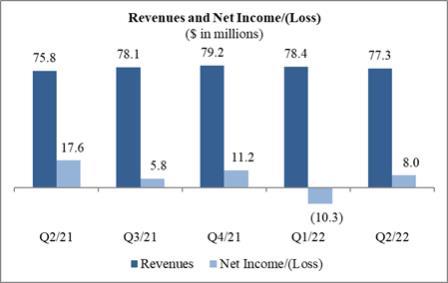Gains and losses also generally arise from the sale of gold earned from management fees paid by our physically-backed gold ETPs, foreign exchange fluctuations, securities owned and other miscellaneous items.
Our effective income tax rate benefit for the six months ended June 30, 2022 was 86.2% resulting in an income tax benefit of $14.0 million. Our tax rate differs from the federal statutory rate of 21% primarily due to a reduction in unrecognized tax benefits associated with the release of the
tax-related
indemnification asset described above and a lower tax rate on foreign earnings. These items were partly offset by a
non-taxable
loss on revaluation of deferred consideration and an increase in the deferred tax asset valuation allowance on losses recognized on securities owned.
Our effective income tax rate for the six months ended June 30, 2021 of 6.5% resulted in income tax expense of $2.3 million. Our effective income tax rate differs from the federal statutory rate of 21% primarily due to a $5.2 million reduction in unrecognized tax benefits, a lower tax rate on foreign earnings and a
non-taxable
gain on revaluation of deferred consideration. These items were partly offset by tax shortfalls associated with the vesting and exercise of stock-based compensation and state and local taxes.
Non-GAAP
Financial Measurements
In an effort to provide additional information regarding our results as determined by GAAP, we also disclose certain
non-GAAP
information which we believe provides useful and meaningful information. Our management reviews these
non-GAAP
financial measurements when evaluating our financial performance and results of operations; therefore, we believe it is useful to provide information with respect to these
non-GAAP
measurements so as to share this perspective of management.
Non-GAAP
measurements do not have any standardized meaning, do not replace nor are superior to GAAP financial measurements and are unlikely to be comparable to similar measures presented by other companies. These
non-GAAP
financial measurements should be considered in the context with our GAAP results. The
non-GAAP
financial measurements contained in this Report include:
Adjusted Net Income and Diluted Earnings per Share
We disclose adjusted net income and adjusted diluted earnings per share as
non-GAAP
financial measurements in order to report our results exclusive of items that are
non-recurring
or not core to our operating business. We believe presenting these
non-GAAP
financial measurements provides investors with a consistent way to analyze our performance. These
non-GAAP
financial measurements exclude the following:
Unrealized gains or losses on the revaluation of deferred consideration:
Deferred consideration is an obligation we assumed in connection with the ETFS Acquisition that is carried at fair value. This item represents the present value of an obligation to pay fixed ounces of gold into perpetuity and is measured using forward-looking gold prices. Changes in the forward-looking price of gold and changes in the discount rate used to compute the present value of the annual payment obligations may have a material impact on the carrying value of the deferred consideration and our reported financial results. We exclude this item when calculating our
non-GAAP
financial measurements as it is not core to our operating business. The item is not adjusted for income taxes as the obligation was assumed by a wholly-owned subsidiary of ours that is based in Jersey, a jurisdiction where we are subject to a zero percent tax rate.
Gains or losses on securities owned:
We account for securities owned as trading securities which requires these instruments to be measured at fair value with gains and losses reported in net income. In the third quarter of 2021, we began excluding these items when calculating our
non-GAAP
financial measurements as these securities have become a more meaningful percentage of total assets and the gains and losses introduce volatility in earnings and are not core to our operating business.
Tax shortfalls and windfalls upon vesting and exercise of stock-based compensation awards:
GAAP requires the recognition of tax windfalls and shortfalls within income tax expense. These items arise upon the vesting and exercise of stock-based compensation awards and the magnitude is directly correlated to the number of awards vesting/exercised as well as the difference between the price of our stock on the date the award was granted and the date the award vested or was exercised. We exclude these items when calculating our
non-GAAP
financial measurements as they introduce volatility in earnings and are not core to our operating business.
Unrealized gains and losses recognized on our investments, changes in the deferred tax asset valuation allowance on securities owned, expenses incurred in response to an activist campaign and impairment charges.





